Workbench Study Concerning the Highest Reliability Outcome for PoL Converters with Different Output Capacitor Technologies
Abstract
1. Introduction
2. General Aspects of Capacitor Technologies and Reliability
2.1. Capacitor Technologies
- Aluminum electrolytic capacitors with non-solid electrolyte, can-type through hole mounting (radial).
- Aluminum polymer can-type V-type SMD capacitors.
- Polymer electrolytic multilayered capacitor in an SMD case.
- Multi-layer ceramic (MLCC) in an SMD case.
- Tantalum MnO2 in an SMD case.
- Tantalum polymer capacitor in an SMD case.
2.2. Brief on the Reliability of Electronic Components
3. The Reliability Standard Used in Paper and the Specifications for Capacitors
3.1. The Mathematical Model Used by the IEC-TR-62380 Reliability Standard
3.2. Calculation of the Failure Rate
- Failure rate for MLCC-SMD case capacitors:
3650.6) × 320.68]} × (10−9)/h = 929.53605 FIT = 0.92953605 F/106 h
- 2.
- Failure rate for tantalum MnO2 SMD case capacitors:
× (10−9)/h = 6050.018 FIT = 6.050018 F/106 h
- 3.
- Failure rate for tantalum polymer capacitors SMD case:
(10−3) × [(1.7 × 3650.6) × 310.68]} × (10−9)/h = 6049.966 FIT = 6.049966 F/106 h
- 4.
- Failure rate for polymer electrolytic multilayer capacitors SMD case capacitors:
3650.6) × 300.68]} × (10−9)/h = 6049.966 FIT = 6.049966 F/106 h
- 5.
- Failure rate for aluminum polymer can-type V-type SMD capacitors:
310.68]} × (10−9)/h = 9072.71 FIT = 9.072 F/106 h
- 6.
- Failure rate for aluminum electrolytic non-solid electrolyte (wet) can-type through hole mounting (radial) capacitors:
3650.6) × 320.68]} × (10−9)/h = 17633.44 FIT = 17.63344 F/106 h
3.3. Life Expectancy of Aluminum Electrolytic Non-Solid Electrolyte Capacitors
- (1)
- Life expectancy depends on the operating temperature, qualification, and test conditions (i.e., technology type);
- (2)
- Ambient temperature for a non-solid electrolyte aluminum capacitor is taken at its immediate vicinity, meaning that overheating of the other components has to be considered. The mathematical formula for the life expectancy is:
4. Experimental Setup for Measurements
- Rds(ON) = 8.2 mΩ, Qg = 3.6 nC and 10 A for Q1.
- Rds(ON) = 2.1 mΩ, Qg = 0.6 nC and 40 A for Q2.
5. Results
5.1. Experimental Results
- The temperature at the surface of the capacitor;
- The component ID from the manufacturer’s catalog;
- The nominal capacitance value and rated voltage;
- The measured actual capacitance value;
- A photo of each capacitor tested;
- The capsule’s temperature TR for each capacitor;
- MTBF number in years;
- The peak-to-peak ripple voltage;
- The failure mode (%) taken from the standard.
5.2. Experimental: First Extension
5.3. Experimental: Second Extension
5.4. Experimental: Third Extension
6. Conclusions
- It provides a comprehensive review of capacitor technology options for low-voltage, high-current PoL converters;
- It provides a guideline for the selection of the proper reliability standard for the calculation of the failure rate for modern capacitor technologies;
- It performs calculations for failure rates and MTBFs for various capacitor technologies when used in PoL converters equipped with eGaN transistors;
- It performs a calculation of the life expectancy for electrolytic-type capacitors based on component qualifications;
- It uses a thermal infrared camera for capacitors’ temperature measurements (used in πT factor calculation) and uses a precise in-circuit measurement of the actual ESR of the capacitors, which helps thermal modeling;
- It uses a precise in-circuit ripple measurement for various capacitor technologies;
- It provides a comparative investigation of the possible failures.
Author Contributions
Funding
Data Availability Statement
Acknowledgments
Conflicts of Interest
Appendix A
- (a)
- The data within the handbook covers intrinsic failures.
- (b)
- The component failure rate depends on a number of operational and environmental factors.
- (c)
- The models adopted are those which give the effect of temperature on the predominating failure mechanisms (which are not normally the “wear-out” mechanism).
- (d)
- For passive components (which is our case), an Arrhenius equation is applied with an activation energy of 0.15 to 0.4 electron volts.
- (e)
- The failure rates given for components include the effects of the mounting on a printed circuit board.
- (tae)i: average outside ambient temperature surrounding the equipment during the ith phase of the mission profile.
- (tac)i: average ambient temperature of the printed circuit board near the components, where the temperature gradient is canceled. (πt)i: ith temperature factor related to the ith junction temperature of the capacitor mission profile.
- (πt)i: ith temperature factor related to the ith junction temperature of the capacitor mission profile.
- τi: ith working time ratio of the capacitor for the ith junction temperature of the mission profile.
- τoff: time ratio for the capacitor being in storage (or dormant) mode.
- τon: total working time ratio of the capacitor with: τon =
- (πn)i: ith influence factor related to the annual cycle’s number of thermal variations seen by the package, with the amplitude ΔTi.
- ΔTi: ith thermal amplitude variation of the mission profile.
- Aluminum electrolytic polymer electrolyte (IEC 60384): πA = 1, = 0.6, = 1.4, .
- Tantalum caps solid electrolyte IEC 60384: πA = 1, = 0.4, = 3.8, .
- Aluminum electrolytic non-solid electrolyte: = 1.3, = 1.4, πA = according to Table A1, .
- Ceramic caps class I: defined temperature coefficient: = 0.05, = 3.3, πA = 1, .
- There is only one annual working phase to consider for permanent working. Table A2 is given for a permanent working phase.
- Values for “ground; stationary; non-weather protected” (equivalent: ground and fixed for Mil-HDBK217F [17]) are given for the French climate, but for other climates they can also be calculated taking the data within the standard’s tables.
| Peak Value of the Pulsed Current | πA | |
|---|---|---|
| Ratio = | ≤1.5 | 1 |
| 1.5–2 | 3 | |
| 2–3 | 10 | |
| Environment Types | Equipment Types | (tae)i | (tac)i | τi | τon | τoff | ni (Cycles/ Year) | ΔTi (°C/ Cycle) |
|---|---|---|---|---|---|---|---|---|
| Ground: benign (GB) | Switching | 20 | 30 | 1 | 1 | 0 | 365 | 0 |
| Ground; fixed (GF) | Trans mitting and access | 11 | 31 | 1 | 1 | 0 | 365 | 8 |
References
- Neacsu, D.O. Telecom Power Systems; CRC Press: Boca Raton, FL, USA, 2017; ISBN 9781138099302. [Google Scholar]
- Huang, W.; Clavette, D.; Zhou, S.; Rodrigues, M. A 32-phase 1200-Ampere DC/DC Converter for Data Center and Artificial Intelligence Systems. In Proceedings of the 2021 IEEE Applied Power Electronics Conference and Exposition (APEC), Phoenix, AZ, USA, 14–17 June 2021; pp. 2017–2023. [Google Scholar] [CrossRef]
- Butnicu, D. A Reliability Comparison between Disrupting eGaN-FET and Cutting Edge Silicon MOSFET Devices in POL Buck Converters. In Proceedings of the International Symposium on Signals, Circuits and Systems (ISSCS), Iasi, Romania, 11–12 July 2019. [Google Scholar] [CrossRef]
- Reusch, D.; Strydom, J. Evaluation of Gallium Nitride Transistors in High-Frequency Resonant and Soft-Switching DC-DC Converters. IEEE Trans. Power Electron. 2014, 30, 5151–5158. [Google Scholar] [CrossRef]
- Anon. Available online: https://epc-co.com/epc/GaNTalk/Post/15421/Design-Efficient-High-Density-Power-Solutions-with-GaN (accessed on 11 March 2023).
- Lidow, A.; De Rooij, M.; Strydom, J.; Reusch, D.; Glaser, J. GaN Transistors for Efficient Power Conversion, 3rd ed.; Wiley: Hoboken, NJ, USA, 2019. [Google Scholar]
- Butnicu, D.; Lazar, A. Why Choose Polymer Electrolytic Output Capacitors for Maximum Ripple Capability and Reliability Performance within eGaN based POL Converters. In Proceedings of the International Conference and Exposition on Electrical and Power Engineering (EPE), Iasi, Romania, 22–23 October 2020; IEEE: New York, NY, USA, 2020. [Google Scholar] [CrossRef]
- Anon. Available online: https://www.marketwatch.com/press-release/polymer-capacitor-market2020-top-leading-countries-companies-consumption-drivers-trends-forces-analysis-revenue-challenges-and-forecast-2026-2020-04-15 (accessed on 11 March 2023).
- Young, J. Polymer Tantalum Capacitors for Automotive Applications; CARTS International: Santa Clara, CA, USA, 2014; pp. 297–311. [Google Scholar]
- Lewis, J. Introduction to Polymer Capacitors. Available online: http://www.electronicproducts.com/Passive_Components/Capacitors/Introduction_to_polymer_capacitors.aspx (accessed on 11 March 2023).
- Weaver, M. Attributes and Challenges of Polymer Electrolytic Capacitors in High Reliability Applications. In Components for Military and Space Electronics; CMSE’18: Los Angeles, CA, USA, 2018. [Google Scholar]
- Zednicek, T. New Tantalum Capacitor Technologies Polymer and NbO. AVX Technical. 2007. Available online: https://www.avx.com/docs/techinfo/newtant.pdf (accessed on 11 March 2023).
- Freeman, Y.; Lessner, P. Evolution of Polymer Tantalum Capacitors. Appl. Sci. 2021, 11, 5514. [Google Scholar] [CrossRef]
- Freeman, Y. Tantalum and Niobium-Based Capacitors, 1st ed.; Springer: Berlin/Heidelberg, Germany, 2017. [Google Scholar]
- Pecht, M.G.; Nash, F.R. Predicting the Reliability of Electronic Equipment. Proc. IEEE 1994, 82, 992–1004. [Google Scholar] [CrossRef]
- Gadalla BS, A.; Schaltz, E.; Siwakoti, Y.P.; Blaabjerg, F. Analysis of loss distribution of Conventional Boost, Z-source and Y-source Converters for wide power and voltage range. Trans. Environ. Electr. Eng. 2017, 2, 9. [Google Scholar] [CrossRef]
- IEC. TR 62380: Reliability Data Handbook; IEC: Geneva, Switzerland, 2006. [Google Scholar]
- Available online: https://www.dsiintl.com/wp-content/uploads/2017/04/MIL_HDBK_217F_N2.pdf (accessed on 11 March 2023).
- Zhou, D.; Wang, H.; Blaabjerg, F. Mission Profile Based System-Level Reliability Analysis of DC/DC Converters for a Backup Power Application. IEEE Trans. Power Electron. 2017, 33, 8030–8039. [Google Scholar] [CrossRef]
- Zhou, D.; Wang, H.; Blaabjerg, F. Lifetime estimation of electrolytic capacitors in a fuel cell power converter at various confidence levels. In Proceedings of the 2016 IEEE 2nd Annual Southern Power Electronics Conference (SPEC), Auckland, New Zealand, 5–8 December 2016; pp. 1–6. [Google Scholar] [CrossRef]
- Zhou, D.; Song, Y.; Liu, Y.; Blaabjerg, F. Mission Profile Based Reliability Evaluation of Capacitor Banks in Wind Power Converters. IEEE Trans. Power Electron. 2018, 34, 4665–4677. [Google Scholar] [CrossRef]
- Sangwongwanich, A.; Shen, Y.; Chub, A.; Liivik, E.; Vinnikov, D.; Wang, H.; Blaabjerg, F. Mission Profile-based Accelerated Testing of DC-link Capacitors in Photovoltaic Inverters. In Proceedings of the 2019 IEEE Applied Power Electronics Conference and Exposition (APEC), Anaheim, CA, USA, 17–21 March 2019; pp. 2833–2840. [Google Scholar] [CrossRef]
- Matsumori, H.; Urata, K.; Shimizu, T.; Takano, K.; Ishii, H. Capacitor loss analysis method for power electronics converters. Microelectron. Reliab. 2018, 88–90, 443–446. [Google Scholar] [CrossRef]
- Anon. Available online: https://epc-co.com/epc/Portals/0/epc/documents/guides/EPC9059_qg.pdf (accessed on 11 March 2023).
- Anon. Available online: https://epc-co.com/epc/Products/eGaNFETsandICs/EPC2100.as-px (accessed on 11 March 2023).
- Prymak, J. Ripple Current Capabilities. 2004 in KEMET Technical Update. Available online: https://www.newark.com/pdfs/techarticles/kemet/Ripple-Current-Capabilities-Technical-Update.pdf (accessed on 11 March 2023).
- Yang, S.; Bryant, A.; Mawby, P.; Xiang, D.; Ran, L.; Tavner, P. An industry-based survey of reliability in power electronic converters. IEEE Trans. Ind. Appl. 2011, 47, 1441–1451. [Google Scholar] [CrossRef]
- Falck, J.; Felgemacher, C.; Rojko, A.; Liserre, M.; Zacharias, P. Reliability of power electronic systems: An industry perspective. IEEE Ind. Electron. Mag. 2018, 12, 24–35. [Google Scholar] [CrossRef]
- Butnicu, D. A Derating-Sensitive Tantalum Polymer Capacitor’s Failure Rate within a DC-DC eGaN-FET-Based PoL Converter Workbench Study. Micromachines 2023, 14, 221. [Google Scholar] [CrossRef] [PubMed]
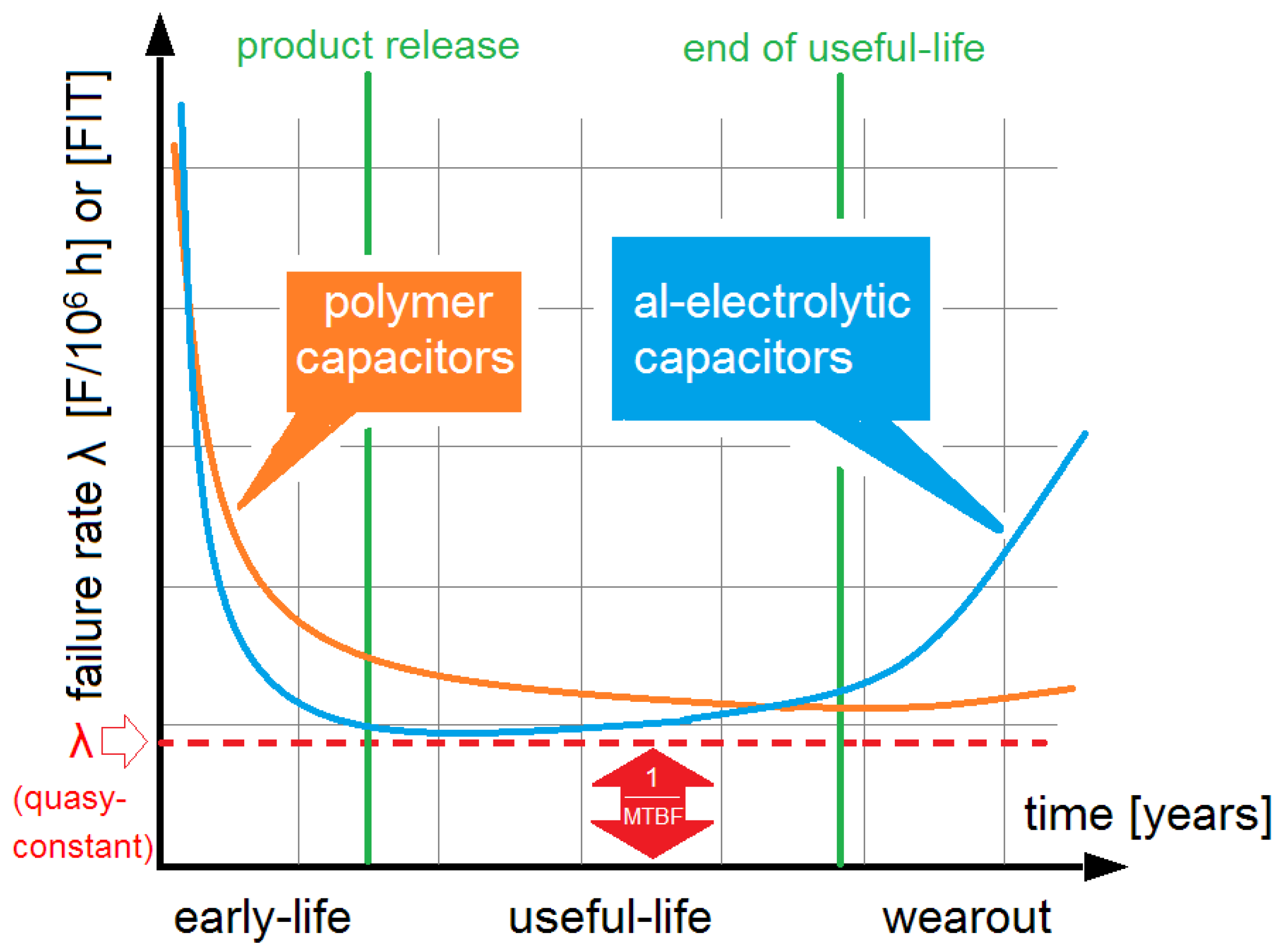
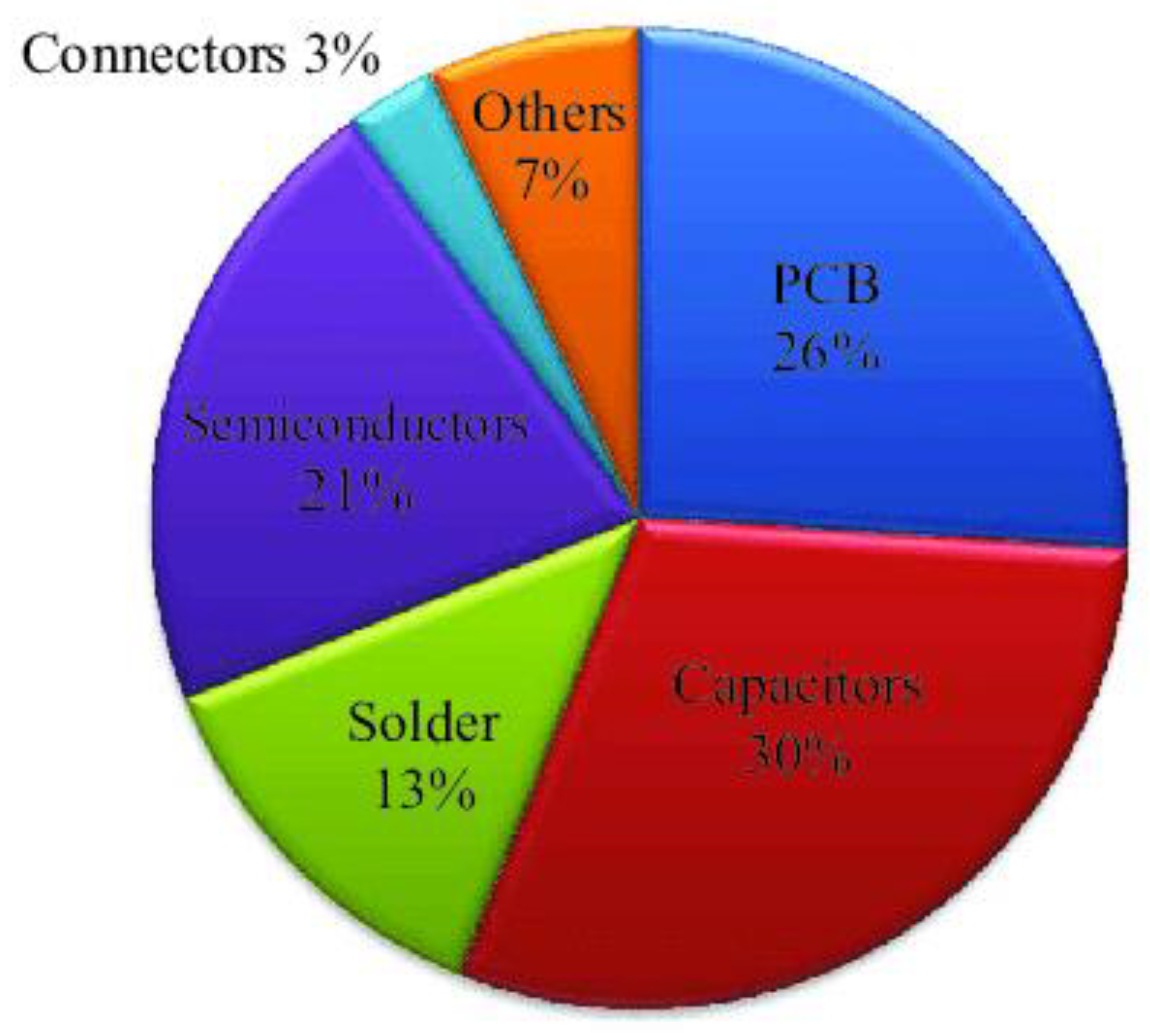
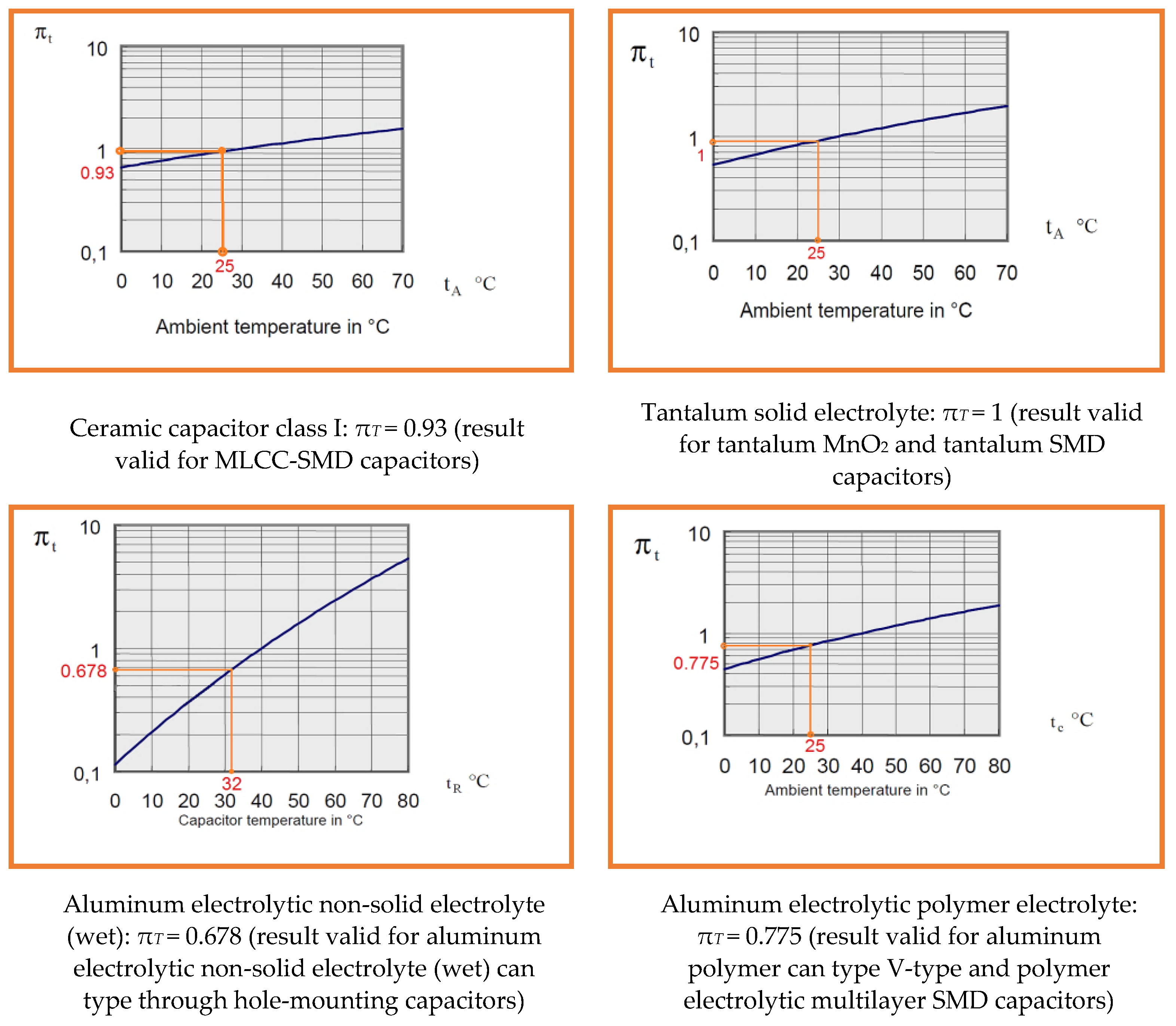

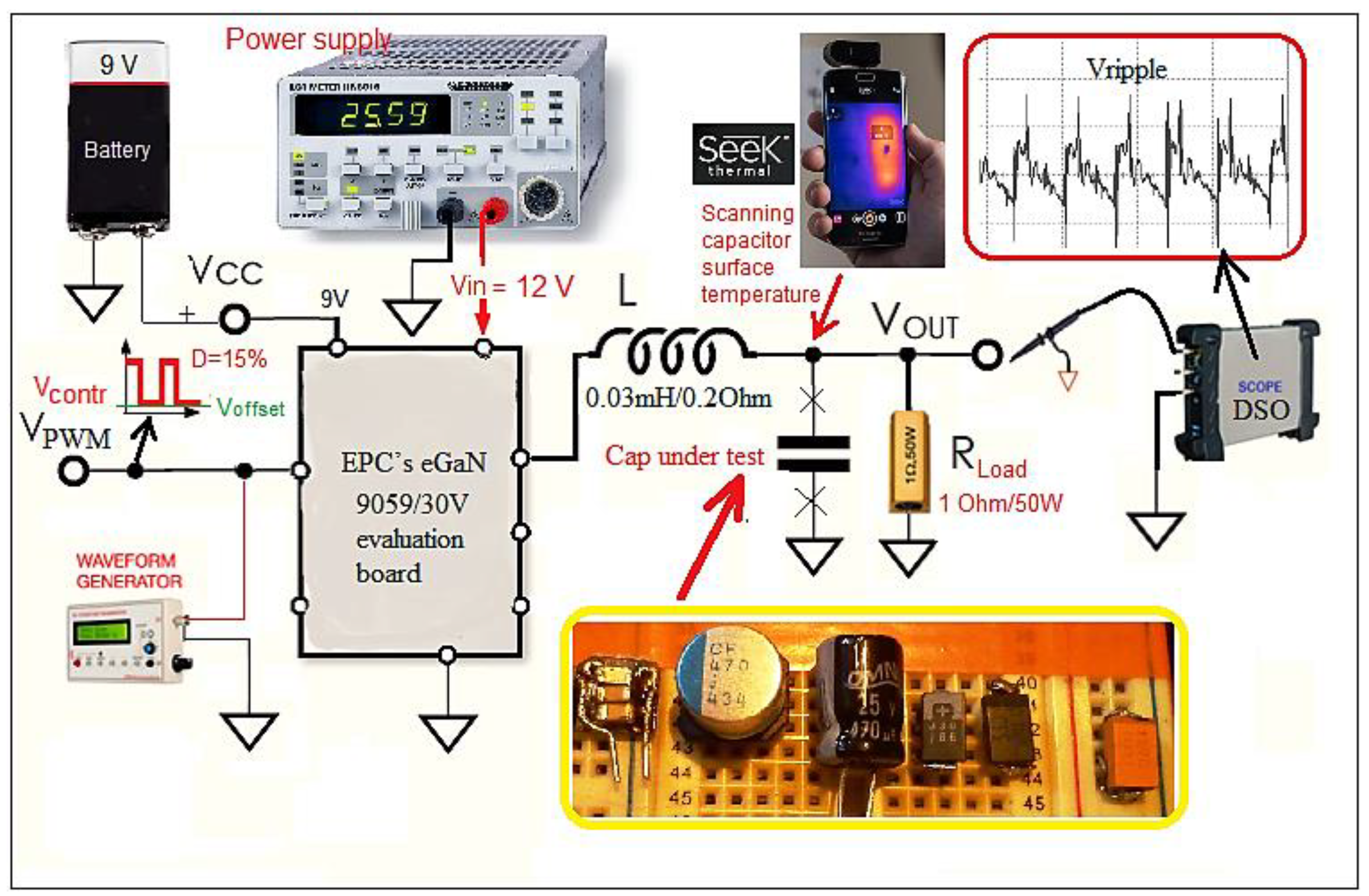
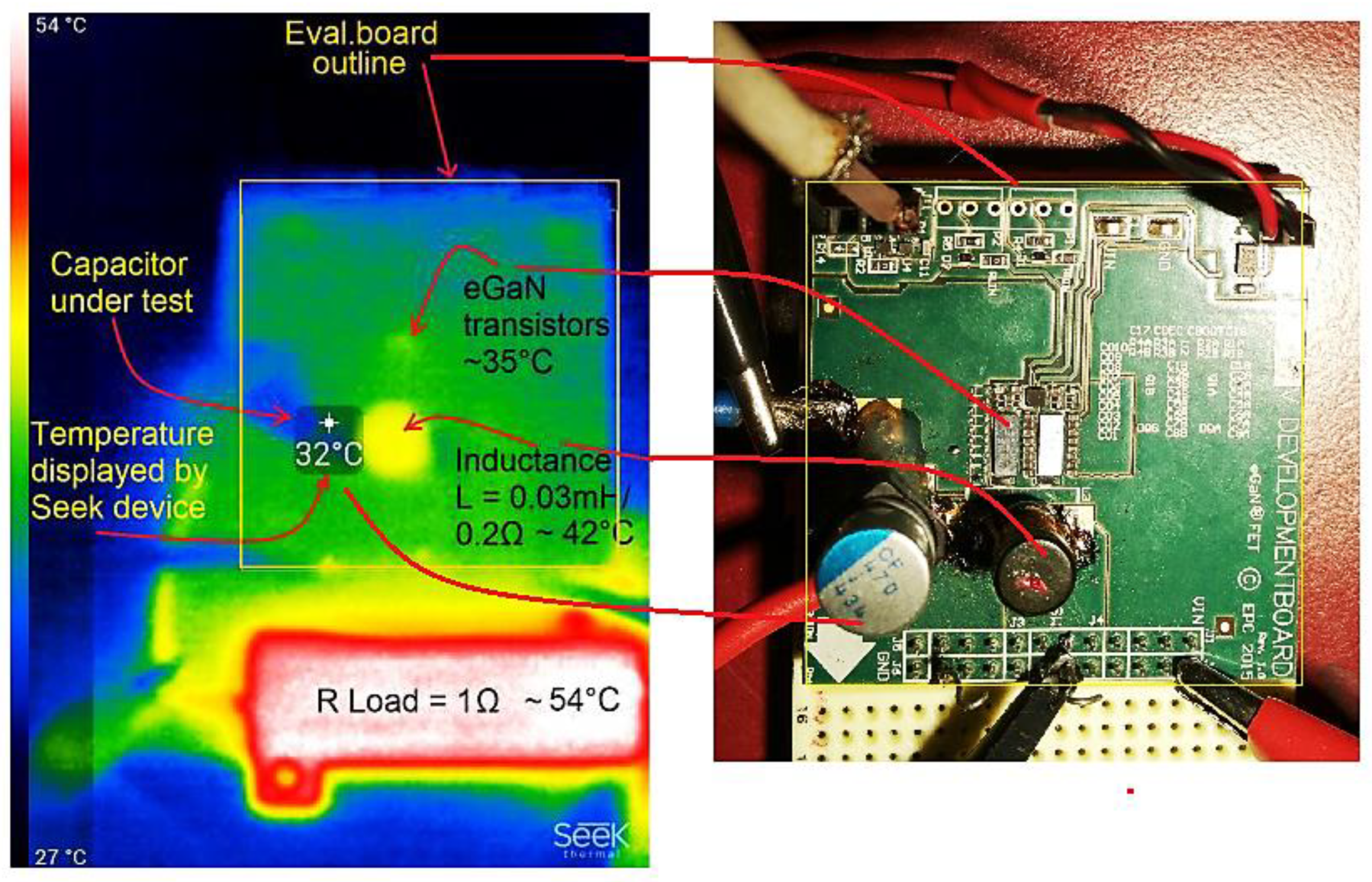
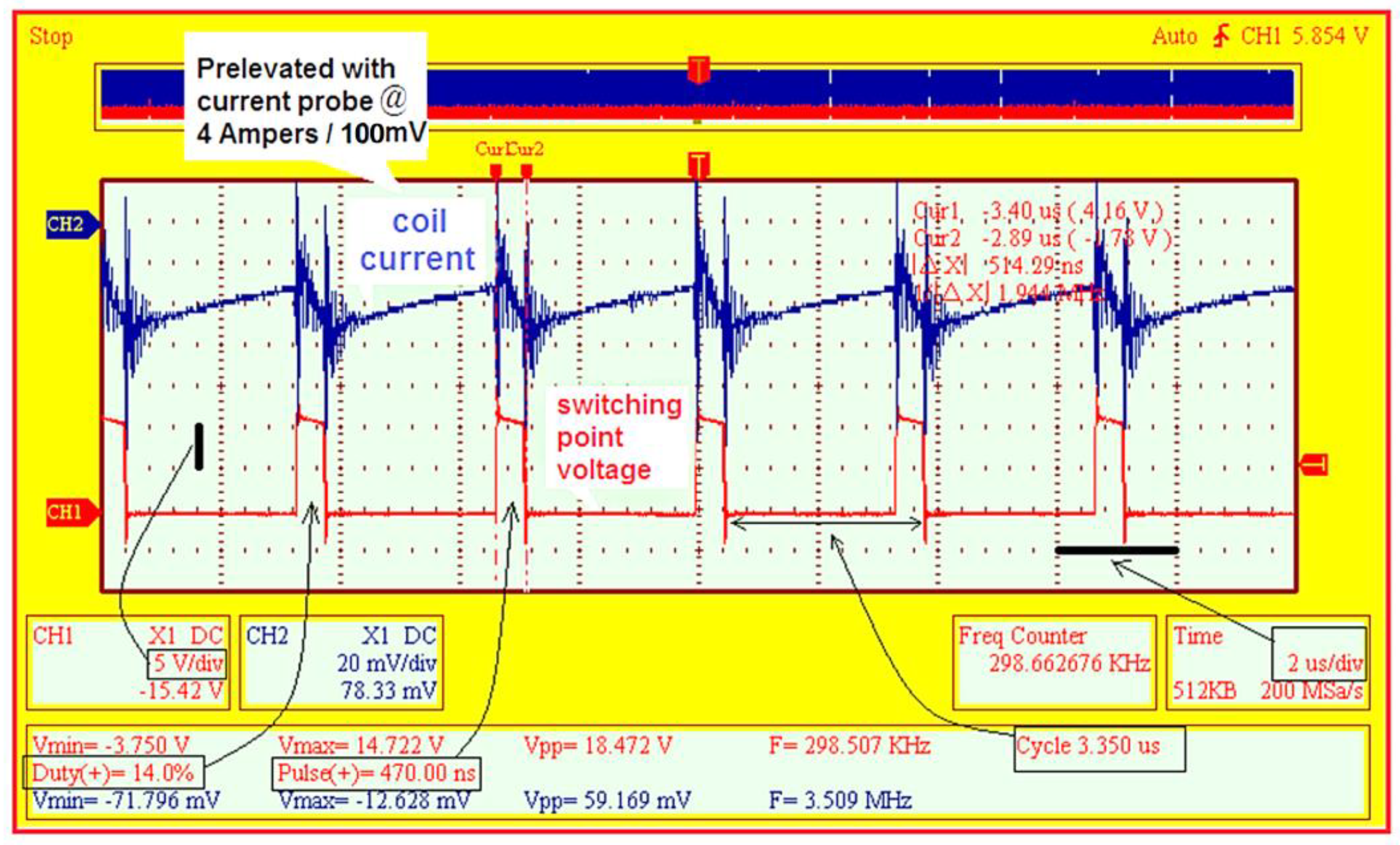

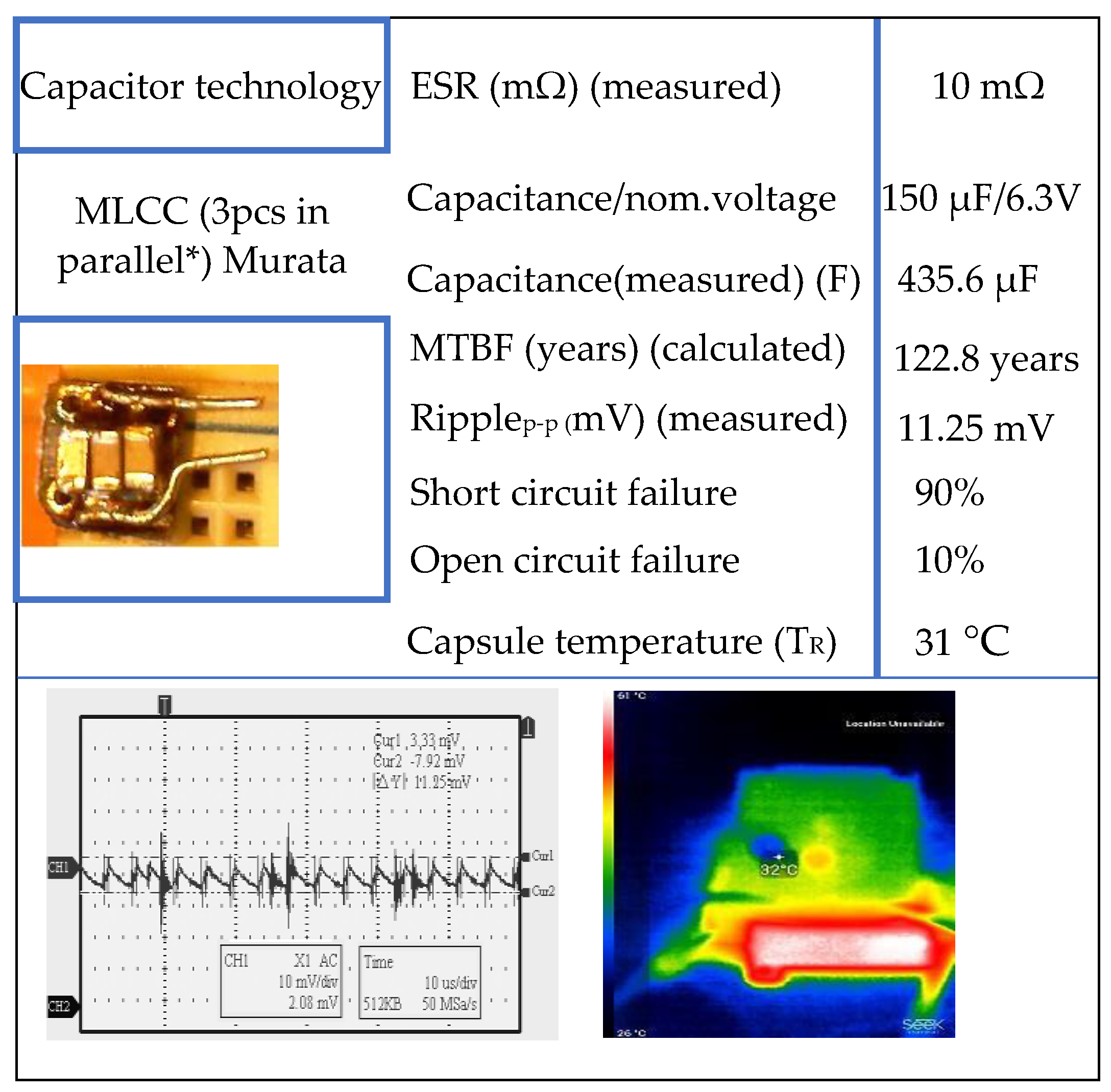


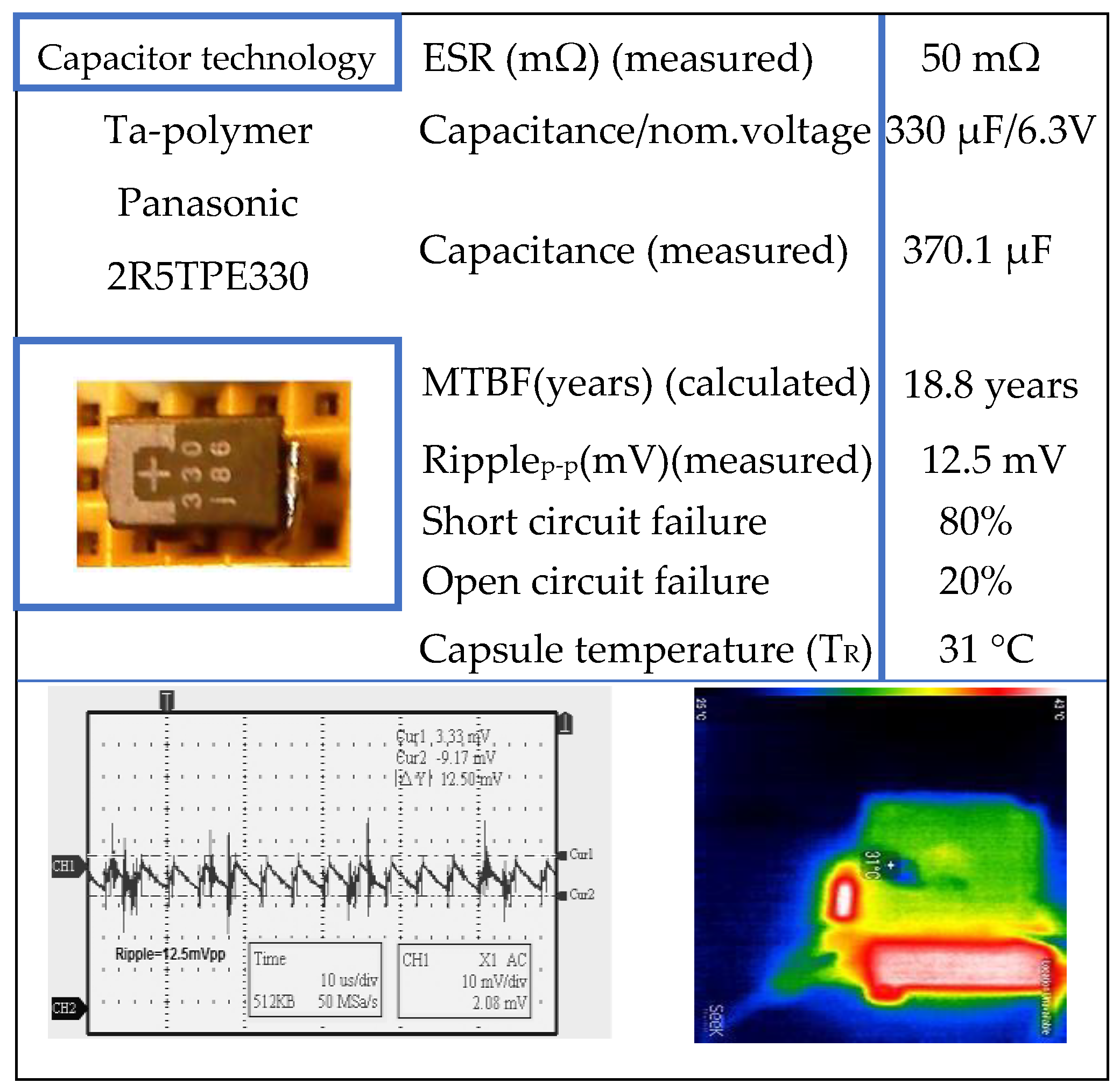

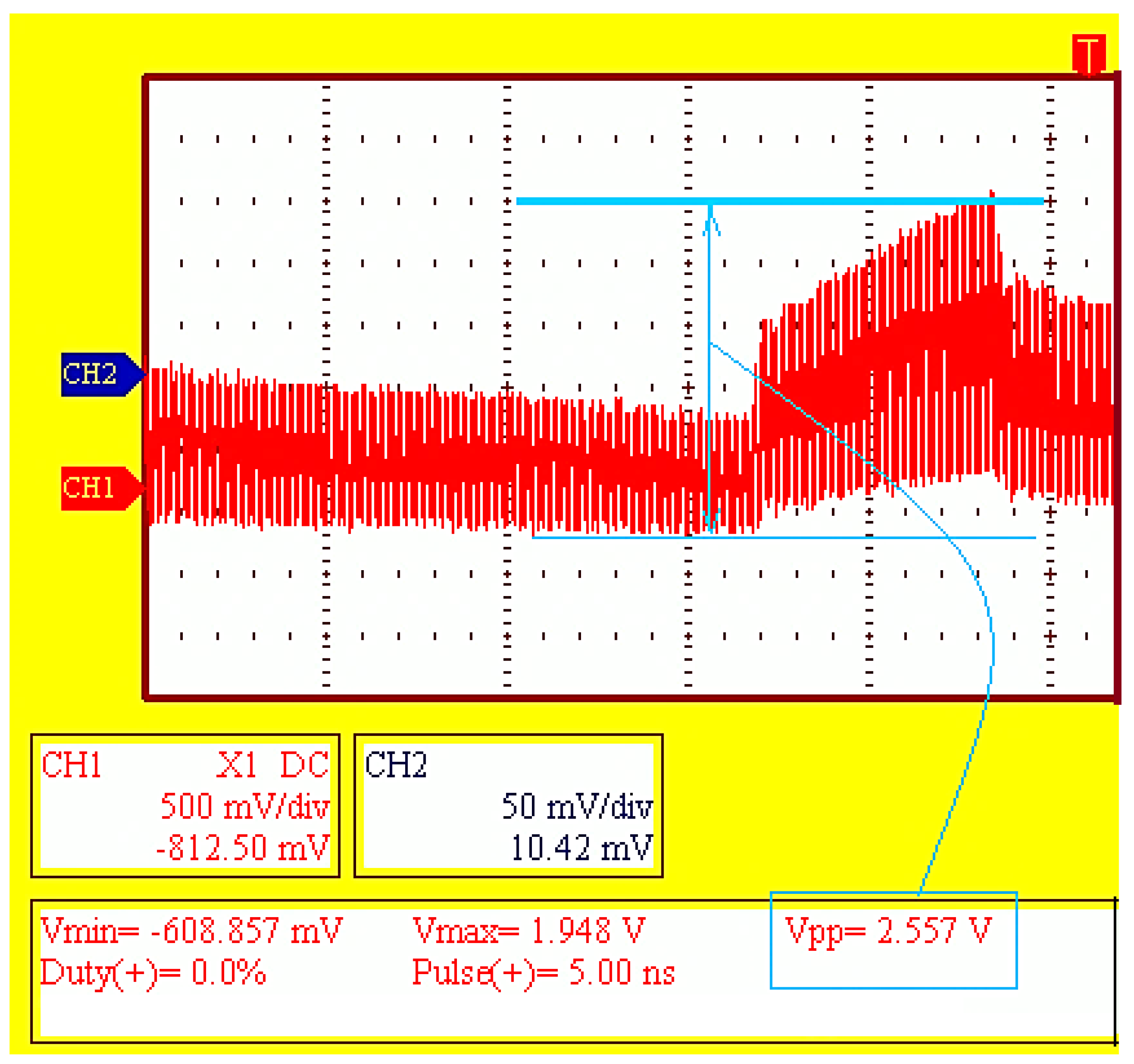


| Parameter | MLCC | Tantalum MnO2 | Tantalum Polymer | Polymer Multi-Layered | Al-Polymer Can-Type | Al Electro Lytic Wet |
|---|---|---|---|---|---|---|
| πT | 0.93 | 0.99 | 0.99 | 0.7565 | 0.7565 | 0.48 |
| TR (ΔTi) | 32 °C | 32 °C | 31 °C | 30 °C | 31 °C | 32 °C |
| Qualification Test | Duration (Hours) | Temperature (°C) |
|---|---|---|
| 1 | 1000 | 85 |
| 2 | 2000 | 85 |
| 3 | 5000 | 85 |
| 4 | 2000 | 105 |
| 5 | 10,000 | 85 |
| 6 | 2000 | 125 |
| Parameter | Value |
|---|---|
| Load resistor | Rload = 1 Ω/50 W |
| Load current | Iout = 1.2 A and 12 A |
| Input current | Iin = 1.2 A |
| Input voltage | Vin = 12 V |
| Output voltage | Vout = 1.2 V (Duty cycle = 7.65%) |
| Switching frequency | fsw = 250 khz |
| Inductor | L = 0.03 mH |
| Ambient temperature | ~25 °C |
| Duty cycle | 15% |
| Capacitor Technology | ESR | Reliability | Footprint | Ripple | Price | Failure Mode | Stable over Time | Stable over Voltage | Optimal Solution |
|---|---|---|---|---|---|---|---|---|---|
| Ta-MnO2 H-chip | very high | •• | •• | ° | ↑ (relatively high) | mostly short | • | • | to avoid |
| MLCC SMD | very low | ••• | ••• | ••• | ↓ (low) | mostly short | ° (aging !) | ° | very good |
| Aluminum electrolytic non-solid electrolyte | ultrahigh | ° ° | ° | ° | ↕ (evenly) | short↔open | ° | ° | to avoid |
| Polymer electrolytic can-type, V-chip | low | •• | • | •• | ↑↑ (high) | mostly open | ° | • | very good |
| Ta-polymer H-chip(flat) | low | ••• | •• | • | ↑↑ (high) | mostly short | • | • | very good |
| Polymer multilayered H-chip(flat) | very low | ••• | •• | • | ↑↑↑ (costly) | mostly open | • | • | the best |
| Capacitor Technology | ESR at 25 °C (mΩ) | Tactual (°C) | ESRactual (mΩ) |
|---|---|---|---|
| MnO2-tantalum | 100 | 32 | 90.751916 |
| Ta-polymer | 50 | 31 | 46.009383 |
| Polymer multilayer | 26 | 30 | 24.258858 |
| Capacitor Technology | TR (°C) at 1.2 A | TR (°C) at 12 A | πT | MTBF at 1.2 A (yr) | MTBF at 12 A (yr) |
|---|---|---|---|---|---|
| Ta-MnO2 | 32 | 40 | 1.02 | 18.86 | 13.99 |
| MLCC | 32 | 35 | 1.02 | 122.80 | 122.83 |
| Al-lytic wet | 32 | 45 | 0.80 | 6.40 | 5.49 |
| Polymer can-type | 31 | 40 | 0.98 | 12.60 | 4.48 |
| Ta-polymer | 31 | 35 | 1.03 | 18.86 | 13.86 |
| Polymer multilayered | 31 | 35 | 0.90 | 18.86 | 10.57 |
| Film | 29 | 31 | 0.83 | 71.39 | 71.40 |
Disclaimer/Publisher’s Note: The statements, opinions and data contained in all publications are solely those of the individual author(s) and contributor(s) and not of MDPI and/or the editor(s). MDPI and/or the editor(s) disclaim responsibility for any injury to people or property resulting from any ideas, methods, instructions or products referred to in the content. |
© 2023 by the authors. Licensee MDPI, Basel, Switzerland. This article is an open access article distributed under the terms and conditions of the Creative Commons Attribution (CC BY) license (https://creativecommons.org/licenses/by/4.0/).
Share and Cite
Butnicu, D.; Lazar, A. Workbench Study Concerning the Highest Reliability Outcome for PoL Converters with Different Output Capacitor Technologies. Energies 2023, 16, 2768. https://doi.org/10.3390/en16062768
Butnicu D, Lazar A. Workbench Study Concerning the Highest Reliability Outcome for PoL Converters with Different Output Capacitor Technologies. Energies. 2023; 16(6):2768. https://doi.org/10.3390/en16062768
Chicago/Turabian StyleButnicu, Dan, and Alexandru Lazar. 2023. "Workbench Study Concerning the Highest Reliability Outcome for PoL Converters with Different Output Capacitor Technologies" Energies 16, no. 6: 2768. https://doi.org/10.3390/en16062768
APA StyleButnicu, D., & Lazar, A. (2023). Workbench Study Concerning the Highest Reliability Outcome for PoL Converters with Different Output Capacitor Technologies. Energies, 16(6), 2768. https://doi.org/10.3390/en16062768








